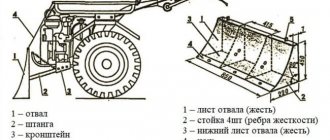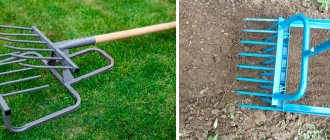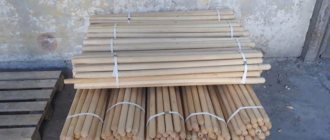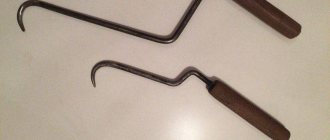Shovel with oval holes
This tool is quite convenient to use. It is used for digging up garden plots - digging and loosening the soil.
How does it work
A shovel with oval holes has a small bucket, the size of which is 210 by 280 mm. The device has four narrow oval slits, thanks to which soil does not stick to the shovel in clumps. The tool lifts large stones and plant roots well.
Advantages:
- Makes work in the garden easier. When digging, there is no need to constantly bend down to manually remove the adhering soil or what is in it;
- The shovel is light in weight, so the summer resident will be able to carry out long work without feeling tired.
About the design of a potato digger for a walk-behind tractor
As mentioned earlier, a walk-behind tractor is a fairly universal tool to make a farmer’s work easier, but without additional attachments it will simply gather dust in the garage until the next loosening of the soil, because walk-behind tractor manufacturers only add a milling cutter to the set of attachments. In order to use your unit to the maximum, you will have to buy additional equipment.
A walk-behind tractor equipped with various devices can replace most manual labor tools, including digging up potatoes.
In the vastness of Ukrainian lands you can find factory-made diggers and homemade potato diggers. Despite the fact that the latter are more practical for our real conditions, because “Kulibins” know better the necessary requirements from a potato digger, “garage” models of mass production quite often come across. Such diggers do not differ in build quality or metal, this is caused by an attempt to reduce manufacturing costs. As a result, the joy of a low price very quickly turns into disappointment from a breakdown, and you will have to finish the digging yourself.
Factory diggers, thanks to close cooperation with dealers and users, are becoming more and more advanced each time, while their service life has significantly increased, in contrast to “garage” production.
You can choose one of two types of potato diggers:
The first type is an improved plow, along the edges of which there are special rods. Thanks to the rods, which are moved apart to the sides, the potatoes are cleared of the soil and placed evenly on the surface of the soil. It should be remembered that the distance between the rods must be less than a small potato.
The latest version of diggers is capable of capturing a wide strip of soil at a time, and unlike a club-shaped tool, the tubers are not sprinkled, so such devices (potato diggers in the form of a cart) are widely used on walk-behind tractors: Kipor, Weima, Kama, Forte, Zirka, Zubr, Motor -Sich, MTZ, Neva, Centaur and other walk-behind tractors from well-known manufacturers.
Potato diggers for heavy walk-behind tractors (with water cooling) deserve special attention. Depending on the power of the walk-behind tractor, you can choose a digger with a working width from 300 to 600 mm, while the digging depth can be from 180 to 250 mm. Potato diggers performed very well when digging up tubers that were planted using a potato planting device.
In our Agromekhanika store you will find various potato diggers for walk-behind tractors that will surely suit your needs. We strongly do not recommend using homemade or uncertified tools to avoid premature failure of your walk-behind tractor. We will always help you choose a suitable model that will last for a long time.
Making your own lancet digger
A homemade potato digger for a lancet-type walk-behind tractor is a simple type of attachment. In some ways it is similar to a cultivator. To construct it, you do not need a lot of material and complex tools. The assembly operations are simple and, with minimal skills, can be done by any gardener.
Necessary materials:
- steel channel;
- plow - it can be cut from an old shovel or a circular saw, but it is better to take high-quality steel with a thickness of at least 5 mm;
- metal corners 40 and 63 cm;
- steel rods in the amount of 8 pieces - can be removed from used forks or broken garden tools and replaced with fittings.
The device should ultimately be small in size. It needs to be made so that it is easy to attach to the Neva walk-behind tractor. There are no moving parts in the lancet digger, so there is nothing to break. The main thing is that the structure itself can withstand and not crack.
Manufacturing procedure:
- The channel is used as a base. A tow hitch is mounted on it.
- A plow is placed on the base.
- Rods are welded to the plow, which separate the tubers from the sand.
Disadvantages of the device:
- The small width of the strip is about 25 cm, because of this, crop losses increase by about 15-20%.
- There is a high risk of damage to the tubers from the knife.
Shovel with oval holes
This device with holes is a convenient tool for work both in the garden and on personal plots. This device is used in the process of digging up potatoes and digging up soil, loosening individual areas of the soil.
This unit is interesting in that it is equipped with a pointed bucket measuring 210 by 280 mm with narrow oval holes drilled in it. Due to these holes, clods of earth do not stick to the bucket, and when digging, large stones and roots are retained in it.
These features of the device significantly make the work easier, since you do not need to often bend down and manually remove everything stuck from the bucket. In addition, because of the holes, the device has less weight, so when digging in large areas, the worker will be less tired.
This unit is convenient for digging up an area with any type of soil, since it simultaneously digs up and loosens the soil. The tool is made of hardened steel and has a protective anti-corrosion layer.
Design Features
To cultivate a small plot of land with good loose soil, a walk-behind tractor is most often used; maintaining it in working condition and providing it with fuel and lubricants does not require large financial expenditures. It is extremely difficult to manually remove potatoes from the beds, even in a small area. Therefore, the owners of such plots make or buy simple accessories for the walk-behind tractor. A fan potato digger is similar to a hiller, but instead of the characteristic wings there are steel rods arranged in the shape of a fan.
This potato digger for harvesting with steel boom rods is one of the simplest mechanisms. Install it on small tractors or walk-behind tractors. It is made easily, by analogy with a bayonet shovel. It is made from a metal sheet bent in a special way and several rods welded to it like a fan to sift out the soil. Average digger dimensions: height – 500 mm, width – 330 mm, weight – 5.5 kg.
Fan potato digger
How to make a miracle shovel?
Making gardening tools is often discussed on gardening forums. All discussions boil down to the fact that first you need to make the main work surface. In the future, additional parts are attached to it, which facilitate the work of the grower. It is proposed to study the following diagram:
- width of the working surface of the shovel 430 mm;
- blade length 300 mm;
- frame length 380 mm, edges are rounded, at right angles to the sides;
- side length 800 mm;
- the frame is made from a corner or from a tube with a diameter of 40 mm;
- the height of the cutting depends on the height of the person;
- loops are provided to attach the frame to the handle; they are placed at a distance of 200 mm from the bottom edge.
It is proposed to start work by making a frame. Some people adapt bicycle handlebars for it. You can take a corner and bend it into a “P” shape. A working cloth is attached to it below.
To make it, you will need a corner to which metal rods are attached by welding. Rod length 300 mm. The pitch between the rods is 50 mm. The result should be a wide fork. They are fixed to the frame.
A stalk is attached to the main structure. It is better to provide loops for it to make the tool movable. Loops are attached at the base of the handle for support. A tube with a diameter of 50 mm and a length of 200 mm can serve as a stop.
A divider frame can be attached to the main tool, on top of the working blade, to sift through the soil. Before work, all connections are cleaned and lubricated. The rods can be sharpened to be able to work on soil of any hardness.
To make the gardener’s work easier, inventors are offering new tools. They are made on the basis of forks or shovels, which have a working surface in the form of a grid. Potato diggers are equipped with stops, soil dividers, and a frame that makes it easy to control the operation of the shovel.
You can buy equipment or make it yourself, but this requires certain skills. Store equipment in a dry place. It is recommended to provide vertical racks with hangers for it.
What is required to create
Tools for making a miracle shovel.
So, to create a frame, you need to stock up on a water pipe with a nominal bore of about 20-25 mm; the backs from old Soviet beds (those made from lightweight duralumin-aluminum pipes) are suitable. The selection of welding equipment depends on the choice of pipe (for aluminum, electrodes and machines for welding non-ferrous metals are used). You also need to purchase rods that will serve as teeth.
The best fitting for these purposes is reinforcement about 0.3 m long. Next, the structure is equipped with a handle, for which an ordinary wooden handle is suitable.
Some are equipped with a carrying handle. The main cost item will be 4 bearings, which should perform the functions of movable fastening of the frames. Everything is completed by one single tool - an inverter welding unit. Why inverter? Because they can cook both non-ferrous and ferrous metals, replacing only the electrodes. And the consumables for it are electrodes of one or two types. After purchasing materials, assembly begins.
First, the pipe is bent so that its shape resembles the letter “P”. If the back of the bed is used as a frame, then all excess should be cut off from it, leaving only the pipes in the letter “P”. To bend a pipe, the required bending points are heated red-hot over a fire, and then bent against a wall or pole.
After preparing such a workpiece, reinforcement is attached to it by welding onto a short crossbar, which is welded parallel to the short frame crossbar (the distance from the frame crossbar to the crossbar with reinforcement is equal to 2 lengths of the reinforcement). This must be done so that the teeth face the jumper.
Next, some semblance of a pitchfork is made from the remaining pipe and fittings. In this case, the width of the forks should be 5 cm shorter than the width of the “P” frame. After which these forks are attached to the frame using bearings. At the final stage, the cutting is inserted into the device.
Forks with spade tips
This equipment resembles a pitchfork, but in addition to the located teeth, there is a bayonet on the edge of the tool. The last tooth is wide and quite sharp.
How does it work
The tool is popular for digging up heavy types of soil. The design of the device is made in such a way that when using it in the garden, a person does not have to make a lot of effort. Thanks to the last sharp bayonet, it easily enters the ground, passing through all the other teeth of the functional tool.
Advantages:
- Convenient for digging potatoes. While digging up a vegetable, the shovel holds it on itself and lets the soil back into the hole. When working with such forks, there is absolutely no need to bend over to collect the crop and rake away the stuck soil. Thanks to the correct design, the shovel performs this function itself;
- Does not damage vegetables. Correct execution of the design reduces the risk of damaging fruits growing in the ground to zero;
- An excellent option for older people. Quite often, pensioners who do not always have good health work in garden plots, and any dacha work cannot be done without digging the garden. Using a spade fork, you won't have to bend or crouch. During work, only the arms and shoulders are involved, the back is completely rested. For such people, this will be the best option, because you can easily complete a large amount of work with the slightest fatigue.
Another device from the same series as “Mole”, “Digger” and “Plowman”. At their core, these are also expanded and strengthened forks, but in this case they also have a support. Convenient for older people. Loosening occurs. Also suitable for digging up potatoes.
Purpose
Most of the purposes of shovels are described above, but there are also individual models that are worth considering.
Shovel for digging trenches
The device is equipped with a rectangular blade with a pointed tip. Using this design, you can easily clear the walls of a trench, well, cesspool and other similar structures without damaging them. An alternative method of application is to uproot plants with large root systems.
Bayonet shovel (or digging)
The main purpose of such a tool is to dig up soil. For such a device, the blade can be shaped like a square or slightly curved, with a sharp tip. A tool with a flat, square-shaped blade is used to dig through dense layers of soil. The curved shape is used for the same tasks as a garden shovel. The pointed tip is good for working loose soil or planting plants.
Shovel
The blade has a shape similar to the shape of a scoop, curved at a certain angle relative to the handle. It has folded edges, which makes cleaning the holes easier. Suitable for additional work when using equipment, mixing solutions.
Garden shovel
Performs the functions of a bayonet and shovel. Excellent for digging medium-density soils, as well as for cultivating large areas of land.
Designed to perform work related to bulk materials.
Snow shovel
Has an enlarged bayonet. Products made from lightweight types of materials (mostly plastic) are suitable for removing loose snow. Specimens with an aluminum bayonet are suitable for removing wet or compacted snow.
Pitchfork
A multi-purpose option with teeth curved at a certain angle and a center of gravity that is shifted downwards. Thanks to this, the forks fit comfortably in your hands when carrying loads. They allow you to do almost any garden work, for example, loosening the soil for applying fertilizers.
Hand drill
A device made of two interconnected sheets. Suitable for digging holes for posts.
It is worth highlighting the so-called miracle shovels. These are tools with the function of loosening the earth. Due to the peculiarity of the structure, such devices, while digging, simultaneously break clods of earth. The position of the handle is much higher, which allows you to dig while standing, thereby making it easier to work with the tool.
These shovels are great for working in the garden. There are several modifications of them.
A potato digger is similar in shape to a pitchfork, but the operating principle is slightly different. The tool makes the process easier and increases digging speed. Such a device can be used for digging up various root crops (potatoes, carrots) and seedlings.
Kinds
Miracle Shovels 1-Plowman 2-Mole
Manual rippers are classified according to the depth of loosening and the complexity of the mechanism. In the simplest models there are only forks and a stop - you can make them yourself. But models with additional parts perform more complex work and the requirements for them are slightly different.
Conventional ones consist of working forks with a stop. They are capable of making work on the ground somewhat easier, but one should not expect much from them. They will plow well-groomed soil well, take some of the load off the worker, but will not be able to break up clods of earth, since they do not have a second segment with teeth. You shouldn’t hope that they will cope with virgin soil. The soil will have to be loosened with a rake.
“Plowman” - they dig up and loosen the soil well, piercing it to a depth of 15 cm. They do not require a lot of worker weight. This model already has a second segment of working forks, however, it will not cope with virgin soil.
“Mole” - removes all the load from the back, which falls on the hands when pressing the handle of the shovel and on the legs when turning out the soil. The penetration depth of the teeth is no less than 25 cm. It is difficult to work with this model at first, but it copes well with plowing. Can work on virgin soil.
Miracle shovels are produced by different manufacturers, so you need to choose a model made of high-quality material, designed for a long service life. It is desirable to have properly sharpened alloy steel forks, which are attached to the shovel by welding or loops - the threads quickly become loose.
If the model does not have a front stop, then the rear one, which replaces it, is attached to the second working forks, and for a model with a front stop, the handle is adjusted to the height of the worker. The emphasis is movable and attached to the frame of the product.
When choosing a hand cultivator, you need to decide on its characteristics: the front stop adds weight and stability to the model. The width of the forks should not exceed 60 cm - the digging will lose quality. The length of the teeth should fit within a gap of 2-3 cm, and the distance between them should not exceed 80 mm. Before purchasing an item, you need to make sure the fastenings are strong.
Tips and recommendations from experienced gardeners
People with many years of experience working in gardens and vegetable gardens recommend starting work on building a miracle shovel by mounting a working part that resembles an ordinary garden fork.
In some models, experts advise using handlebars from an old bicycle for greater comfort while working.
Simple designs allow wooden handles, but professional gardeners warn that this material is short-lived and will need to be replaced after a few seasons.
The height of the handle is set to chest level. This puts less strain on your back.
This is interesting:
Technology for planting potatoes with a walk-behind tractor
Useful properties, cultivation features and description of the purple potato variety
What kind of shovel should be used for digging potatoes?
Experienced gardeners prefer products whose canvas is not made of a solid sheet of metal, but with gaps, holes and crevices.
Main parameters:
- bucket size – 210x280 mm;
- four oval or oblong slits.
Advantages:
- such a shovel is lighter, and therefore working with it requires less effort;
- there is no need to regularly clean the blade from adhering lumps of soil and weed roots;
- This is a multifunctional device that performs several tasks simultaneously.
The working blades in such products are made of high quality steel, treated with special anti-corrosion agents.
Functions
The tool performs several important functions at once:
- digging up soil, digging tubers;
- loosening the soil;
- separation of the root system, stones;
- cleaning tubers from soil;
- Suitable for digging carrots, beets and other root vegetables.
Some farmers use a combination shovel-fork. The upper part of the blade (from the handle to the middle) consists of teeth, and the lower part is the tip of the shovel. The unusual design is easy to use and has functionality similar to lightweight shovels.
General information about the mechanism
A potato digger is a special towed device for a walk-behind tractor or mini-tractor, which allows you to separate the tubers from the soil and dump them on the surface. Afterwards, all that remains is to collect the tubers in a suitable container. The potato business will develop successfully with such a device thanks to mechanization.
Device types:
- ogival;
- screening or vibrating;
- conveyor
The lancet potato digger has a simple design and is easily suitable for any mini-tractor. There are no moving parts in the device, which simplifies manufacturing. The digger cuts the soil with a knife. Next, the earth falls on steel bars, from where the visa is poured. Potato fruits are retained by the twigs and fall on top of the ground in their pure form.
This device is effective only on soft and dry soil. Wet soil will be cut in clumps, making it impossible to separate the potatoes from it. This will require additional effort. The simplicity of the design should not captivate farmers in the northern regions - the device simply will not work. However, a homemade potato digger for a lancet-type mini-tractor can be made quickly, even without drawings - this is a significant advantage.
The vibration-type mechanism (also called a screening mechanism) consists of a ploughshare, a barrel and a drive. This is a productive device, but difficult to manufacture. Moving parts add challenges to assembly. Operating principle:
- The ploughshare undermines the earth along with the fruits.
- The material falls on a table made of twigs, where the soil is loosened and spills down through the sieve.
- On the opposite side, tubers are poured on top of the ground.
The vibrating table complicates the design, but allows you to work on hard and wet ground. Thanks to vibration, lumps of earth are broken up, and the fruits become relatively clean.
Installation with a conveyor allows you to work on any type of walk-behind tractor or mini-tractor. The design is similar to a rumble digger, but there is a conveyor immediately behind the plowshare. Its purpose is to support the tubers on the platform to better clean them from adhering earth. The device is more practical than a vibrating digger and is suitable for all types of soil. It is not advisable to use a digger with a conveyor on soft, loose soil.
The choice of design must be made depending on the type of soil on which to work. The rule is simple: the lighter the soil, the simpler the potato digger needed. You can also make a conveyor, but it will not be useful on dry sand. These will be extra costs. However, if you need to make a potato digger for a mini-tractor with your own hands, the drawings and dimensions should be selected so that the mechanism harmoniously fits the traction device.
Garden ripper "Mole"
This is perhaps the most famous invention of recent years. We have already written about the mole shovel on the website. So you can read in more detail about the device and digging technology there. In the meantime, I advise you to watch the video of “The Mole” in action, at least three times the gain in time and quality. But they have already written to me that this invention is not suitable for all types of soil, and besides, not everyone can bear the weight of the device.
The miracle ripper “Digger” consists of two cutting forks and a ripper. The ripper is equipped with a foot rest. The two cuttings at the top are connected to each other and allow you to adjust the height of the cuttings to suit your growth. The double handle allows the unit driven into the soil to simply be pulled towards itself, without wasting the effort of the back muscles on lifting and dumping the soil.
The miracle shovels “Krot” and “Krot-B”, “Plowman” differ from the “Digger” in certain details - the design and type of handle (metal, solid, rounded), soil grip width (25-40 cm), digging depth 15- 30 cm), but have the same advantages. They all work on the principle of double forks moving one through the other. They loosen the soil without turning over the soil.
Miracle shovels “Light Digger” and “Digger” are variants of devices for digging up light crumbly soils. They have a wider working part, it is fork-shaped with a working width of up to 60 cm, attached to a handle. At the top of the bayonet there is a crossbar for resting on the bayonet with both hands. When you press the crossbar with your foot, the double forks move towards each other and break up lumps, which easily crumble under the pressure of your foot.
Types of shovels for digging soil in the garden
For digging the ground, a bayonet shovel is used, which is a tray (bayonet) attached to a handle at an angle of 180°. The range of these garden tools is quite wide; they differ in several parameters.
The soil in the vegetable garden is usually dug with a bayonet shovel.
Blade material
The working part of the shovel (bayonet, blade, blade, tray) can be made of various materials:
- Low carbon steel. The most common and inexpensive option, very popular among gardeners. A steel blade is heavy, has low bending resistance, is highly rusty and therefore not durable. Easy to sharpen. The tool is quite durable and suitable for any soil, especially heavy soil, but wet soil sticks well to it.
- Teflon coated steel, painted or galvanized. A more expensive modification of the previous material, to which damp soil sticks less. The coating reduces friction, but is not durable.
- Stainless steel. The blade is more fracture-resistant, does not corrode, and is durable. It weighs a little less than a regular steel tool, but quite often you come across a low-quality product (stainless steel is thin and soft) that is not suitable for heavy loads. It's inexpensive.
- Titanium and its alloys with aluminum. Lightweight, highly durable and completely stainless steel tool. The earth hardly sticks to it, but the blade does not bend at all and breaks with serious effort. More suitable for digging up already cultivated areas (not virgin soil). It's difficult to sharpen. A significant disadvantage is the high price.
- Rail (spring) steel. High alloy steel is strong, flexible and resilient. The blade can withstand heavy loads and is ideal for working with heavy dense soils. The disadvantages include high cost and heavy weight.
From personal experience I can say that titanium shovels are the most convenient, but also expensive. It is impossible to leave such a tool unattended for a long time, since it attracts various people who like to rummage around their summer cottages and garden plots.
To reduce weight, holes are cut in the bayonet
Video: choosing a shovel by sound
Blade shape
According to the shape of the working part of the shovel there are:
- classic rounded blade, suitable for clay and hard soils;
- rectangular blade, suitable for sandy and loose soils;
- a specialized multi-sharpened blade with teeth, visually reminiscent of a saw - for virgin soil and soil densely penetrated by plant roots;
- a pointed (triangular) shovel with sharply sharpened blade edges - suitable for any soil.
The American shovel is a cross between a pick-up and bayonet shovel
Handle material
The shovel holder, that is, the handle, can be made from the following materials:
- Wood. Various types of wood are used (pine, ash, birch, aspen, etc.). Lightweight, easily processed and easily sanded material, but not durable. Wooden cuttings are sometimes painted or varnished.
- Aluminum. The corrosion-resistant, lightweight and durable aluminum handle is expensive.
- Carbon fiber. Fiberglass stems are expensive, but very strong, durable and lightweight.
- Plastic. Light weight, but weak and brittle material.
- Steel. A hollow metal tube that has a decent weight and heats up at sub-zero temperatures.
Telescopic handles are not very durable
dimensions
The dimensions of the working blade can vary in the following ranges:
- width - 180–210 mm;
- length - 335–405 mm.
The bayonet of a shovel can have different sizes
The height of the cutting is most often from 110 to 160 cm.
Alternative tools
Based on standard tools, alternative devices for digging up potatoes were created. They are called potato diggers. They are a cross between a shovel and a pitchfork.
It is proposed to consider a tool created by a group of scientists led by Boris Kozmenko. A shovel for digging potatoes is the following diagram:
- the handle is attached to the working blade;
- the canvas is a lattice; the rods are arranged at a certain pitch;
- the lower part is a small, wide bayonet made with a wedge;
- at the base of the working blade there is a stop, which is a simple structure; a metal triangle located at right angles to the handle and a tube that is placed perpendicular to the triangle.
The Kozmenko shovel is recommended to be used for soil of any hardness. The working cloth is placed at a distance of 30 cm from the stem and pushed in with your foot until it stops. The handle is moved towards itself, lifting the potato tubers. Raise the root crops and place them on the surface of the bed.
The grid on the shovel sifts the earth. Only tubers, tops and grass, if any, remain on the working surface. The Kozmenko potato digger makes work in the garden easier and reduces the time for harvesting root crops. When working, the load on your back is significantly reduced.
Some potato diggers are called miracle shovels. They are increasingly being purchased in specialized stores. Experienced gardeners make tools with their own hands. What is a miracle shovel:
| № | Helpful information |
| 1 | teeth are attached to the rectangular frame. Externally, the design resembles a pitchfork. The frame can be round |
| 2 | to the base of the frame, in the place where the forks are attached, a large bracket is installed, to which the working handle is attached |
| 3 | The tool is used for any soil. The pitchfork is pushed into the ground near the potato bush. To push them deeper, press on the frame to which they are attached. They give the pen to themselves. The pitchforks come out of the soil along with the root crops. All that remains is to collect the tubers |
The miracle shovel has many advantages. It allows you to dig up potatoes, regardless of the hardness of the soil. The tool saves time and reduces the load on the worker’s back. It is used not only for digging root crops, but also for preparing the soil in the autumn and for loosening the soil.
The miracle shovel has various modifications. Devices for digging potatoes are attached to the main structure, which facilitate the work of the gardener. One such device is a frame with a mesh. It is located on top of the work surface. The miracle shovel was called “Plowman”. How to use it:
- place the working surface near the bush;
- pushed into the ground with your foot. The frame with the mesh remains on the ground surface;
- the stop prevents the shovel from going too deep into the soil;
- using a frame that extends from the working surface, the tubers are taken out;
- the mesh placed on the soil retains the soil. Only tubers rise to the surface of the bed.
When working, another tool is used - rotary forks. With their help, they dig up not only potatoes, but also other root crops, loosen the soil, and carry out hilling. This requires little effort and minimal stress on the back. What is the tool:
- the forks have a wide blade;
- the handle is attached to the side, not in the center, like a standard working tool;
- the forks can be rotated;
- use them for any soil. The pitchforks are pushed into the ground. Pull the handle towards you to get the tubers, lift the tool, turning the potatoes onto the surface of the bed. In this case, all the earth is sifted. Only tubers with tops remain in the garden, but it is recommended to cut them off.
Tools are offered in many specialized stores in Moscow and other cities. Their cost is from 800 rubles. Alternative potato diggers cost from 1.2 thousand rubles. Some gardeners prefer to make their own tools.
Additional functions
A potato digger is a multifunctional gardening tool that simplifies many tasks. You can replace an outdated shovel and fork using the Harvest potato digger. It allows you not only to dig up root crops, but also to dig up beds and loosen the soil. Design features:
- forks made of tool steel with fine teeth (7 pieces);
- a pedal on hinges that acts as a lever.
The furrow width is 28 cm, the loosening depth is 25 cm, the weight of the unit is 3 kg.
Long pins not only dig up the soil, but also break up clods of earth, making the soil homogeneous. The bush of the plant is easily removed from the ground; the potatoes are not pierced or cut. When moving to the next potato bush, you do not need to lift the tool; you just need to step back and pull it towards you.
Another modern unit is the “Farmer”, which combines 5 tools. They can dig potatoes, harrow, loosen and turn up the ground. In addition, it is used for spreading manure. To activate the “potato digger” function, you need to secure the plates along the arched lever. Pressing the lever raises the forks upward. Shaking the tool by the lever releases the potatoes from the soil.
Design parameters:
- length of teeth and working blades – 25 cm;
- depth of penetration into the ground – 20 cm;
- size – 120 cm;
- unit weight – 3 kg.
There are also potato diggers that work on a different principle. They are a versatile alternative to a shovel. The entire unit rests on one metal pin stuck into the ground. Rotating the handles clockwise moves the curved teeth made of hardened steel. The tubers are picked up along with the soil and turned to the side.
Kinds
The design of a miracle shovel for digging and loosening the earth can be different. For example, not all models are equipped with a front stop. On the one hand, this is good, since a design of this type is less bulky and its weight is reduced. But on the other hand, the absence of a front stop ensures the stability of the tool.
Conventionally, the models can be classified into regular, “Plowman” and “Mole” options. Typically, most modifications of the first type are performed at home. It is these varieties that do not have a front stop. The disadvantages of products of this type include the need for frequent tillage, since they do not solve the problem of piles of earth. Such tools are suitable mainly for black soil.
The Plowman modifications were developed with the option of loosening the soil. The average bayonet length ranges from 10 to 15 cm. This is convenient because it allows you to cultivate different types of soil. The bayonet easily penetrates the ground, regardless of the user’s weight.
The “Mole” variants are characterized by a longer bayonet length. It is about 25 cm and is designed for deep digging of the earth. Potholes can be immediately used for planting garden crops. However, working with this tool already requires some effort. This will be especially noticeable if you have to cultivate fairly compacted soil or alumina.
You can use such devices for digging up soil for planting potatoes only in regions of the country where the soil is black soil and freezes no more than 5-10 cm. For a more severe climate, such a bayonet length is not enough. Therefore, a shovel will not be able to process the soil efficiently, which is bad for high-quality soil renewal and ensuring a good harvest.
Regarding the fastenings, it is worth noting: for modifications without a front stop, the rear stop is welded to the comb of the second forks. The “digger” modifications have an adjustable handle. It is attached with two bolts, and the height must be selected according to the height of a particular person. The stop of such models is movable, attached to the frame. Light-digging analogues are distinguished by rounded stops and an arched non-adjustable handle.
As for miracle snow shovels, such models are designs with an oval-type auger. They come in one- and two-stage types. Single-stage modifications have a screw operating in constant frequency mode. Two-stage analogues operate by capturing snow with an auger and throwing it out through a special device driven by a rotor.
Finger drum
If possible, a finger drum can be installed on the elevator. It is a piece of pipe onto which fingers of the required length are welded.
The part should be of such a size that it does not reach the grill by just a couple of centimeters. The drum is mounted on a special axis, which has a welded sprocket.
Using a chain drive, the drum axis is connected to the wheel shaft.
If everything is done correctly and the calculations are correct, your fingers will break up the hard, dried soil, which falls along with the tubers onto the elevator grate. As a result, the potatoes will be as free as possible from adhering soil.
To make this option you will need:
large diameter pipe cut- round sheets of metal
, which will subsequently cover both holes in the pipe; - steel rod
, which will serve as an axis of rotation; - long cylindrical metal fingers
(you can use reinforcement used to reinforce concrete).
The entire structure is manufactured using resistance welding.
Buying a factory potato digger is a very expensive undertaking. Therefore, if you don’t have extra money and have a lot of time, as well as a well-working head and hands, you can easily save a decent amount.
After watching the video, we can conclude that it is important to be careful and conscientious about your work, then a homemade potato digger will be able to serve you without breakdowns or downtime for a very long time:
Probably, every owner of a large personal plot or vegetable garden wants to minimize the labor intensity of land work and reduce the time of tillage to a minimum, which is why gardeners strive to acquire a walk-behind tractor and various equipment for it. If you are the happy owner of this useful equipment and like to grow a lot of potatoes on your plot, then it makes sense to think about the need for a potato digger for mechanical harvesting. Now you can buy various designs and improved equipment for all types of walk-behind tractors, or you can put in a little effort and make a digger for a walk-behind tractor with your own hands. In this article we will introduce you to the varieties of this device and tell you how to make a potato digger yourself.
Electrical devices
An inexperienced person may be surprised how a shovel can be electric, and what is common between an electric and a conventional device.
If we talk about appearance, then there is practically no similarity between a typical snow shovel and an electric unit, if you do not take into account the long telescopic handle (a similar option can be found on a manual scoop). This holder allows you to work without bending too much. However, there is a big difference.
It is difficult to find a shovel, the working surface of which is not a plane, but an auger, which could be replaced with a brush for cleaning tiled paths from dust and dirt in warm weather. To some extent, it can also be considered the working surface of a shovel, at least its purpose is the same - to throw snow aside, but the performance of automation is incomparable to muscle strength.
A shovel with an electric motor is capable of throwing snow from private paths at a distance of up to ten meters, while the clearing speed reaches 136 kg/min. As we see, even the most dexterous and strong person cannot bring such results.
In conclusion, we note that on the modern market there are a variety of shovels for digging soil, as well as other solutions to make the work of gardeners and gardeners easier:
- electrical;
- mechanical;
- manual;
- factory made;
- homemade;
- cheap;
- expensive.
In any case, our contemporaries - lovers of garden land work - will in no case be left without equipment that would greatly facilitate their work. Anyone can choose a tool for themselves, both for its purpose and for their budget.











